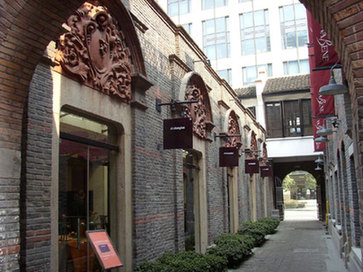Shikumen obsession goes online
Updated: 2008-04-30 10:16

Shikumen, the traditional Shanghai-style housing, is shown in a file photo. A brother and sister at East China Normal University in Shanghai have devised a geographic data system that will give people an interactive overview of shikumen. [File Photo: hi.baidu.com/qianjindexin]
A brother and sister at East China Normal University in Shanghai have devised a geographic data system that will give people an interactive overview of shikumen and longtang, the traditional Shanghai-style housing and lanes.
Shikumen, literally a stone gate house, was the most popular housing style in the city in early 1900s. Shikumen houses were arranged in rows to form communities connected by longtang or the lanes.
The data system was unveiled after the two geography major students collected community information and set up a database of 6,000-plus local lanes and more than 200 shikumen areas.
By typing the name of a shikumen house or a longtang into the system or by clicking on an electronic map, users can learn about individual shikumens, community pictures, history, preservation records and even a satellite image.
An overview of the total number of shikumen, their layouts, historical value and connecting bus routes will also be available on the system.
Shen Li, one of the system's developers and the elder brother of the team, said that the idea to develop the system was inspired by an interest in the city's contemporary architecture three years ago.
"I became quite obsessed with shikumen houses and longtang lifestyles when I was a third-year undergraduate student in 2005," said Shen, who is now doing his postgraduate program at ECNU.
Shen has collected information since September 2005 about the development of longtang over the past 140 years. Shen's younger sister, who was a freshman at ECNU's information geography department at the time, joined his research and helped turn the information into a digital database.
The brother and sister finished a demonstration model earlier this month and this won second prize in the city's university science and technology innovation work contest. The first software application is expected to be completed this September.
Lin Tuo, a professor with ECNU's modern Chinese city research center, said that it was rare to see such a broad range of city architectural culture research materials. He said the university would recommend the software be used by the city's history and urban management departments.
|
||
|
||
| Eating out:
Towering above the pack
Bars&Cafes: Cool Q-usine Weekend&Holiday: A solo exhibition from a Dutchman Shopping: A nocturne for ladies What's on: One with everything |
|
||
| Eating out:
Italian chef sports rosy outlook
Bars&Cafes: Sports bars in Shanghai Weekend&Holiday: Stuck in Shangers Shopping: Sweet serenity What's on: Discover the heart |

